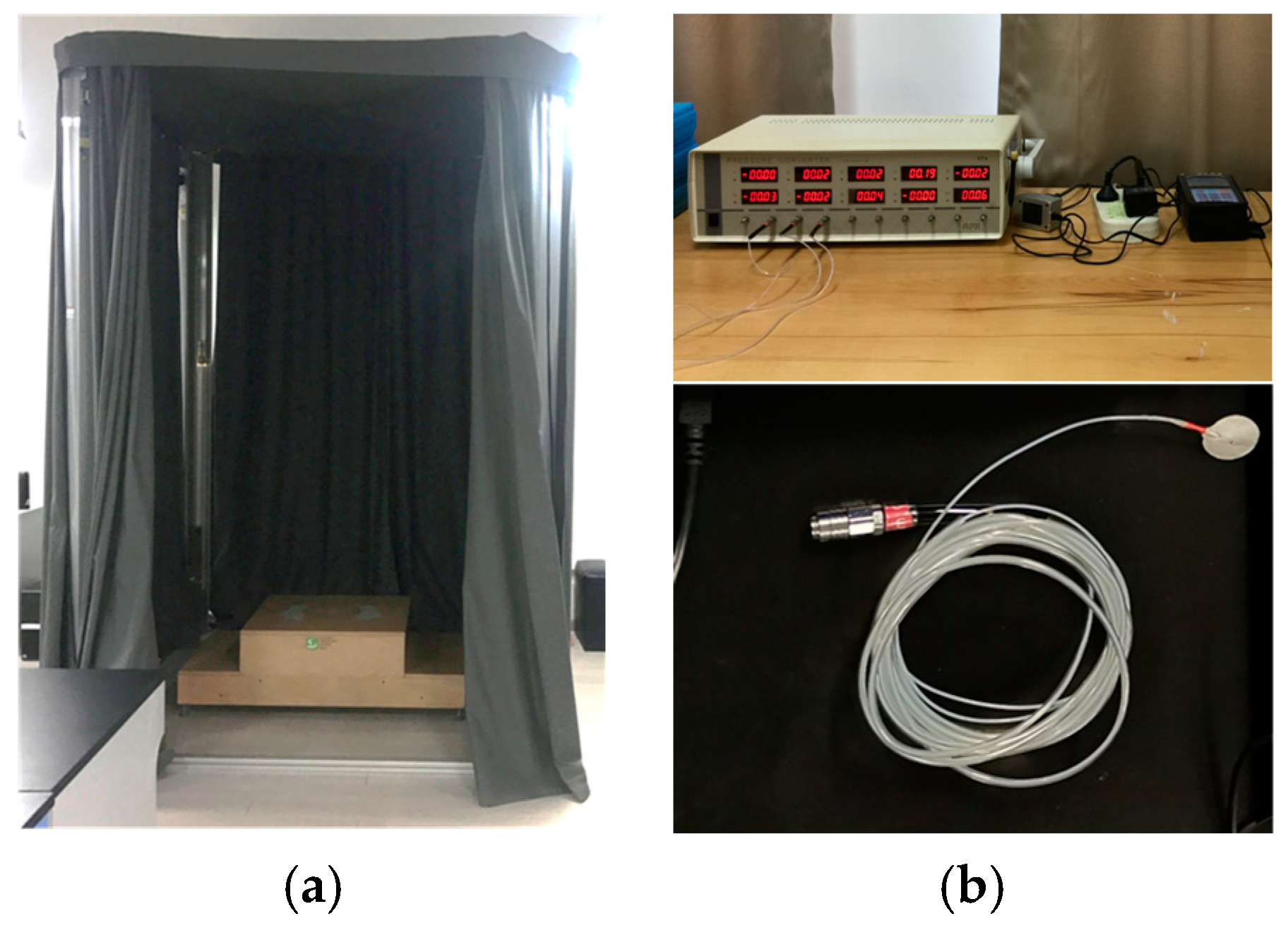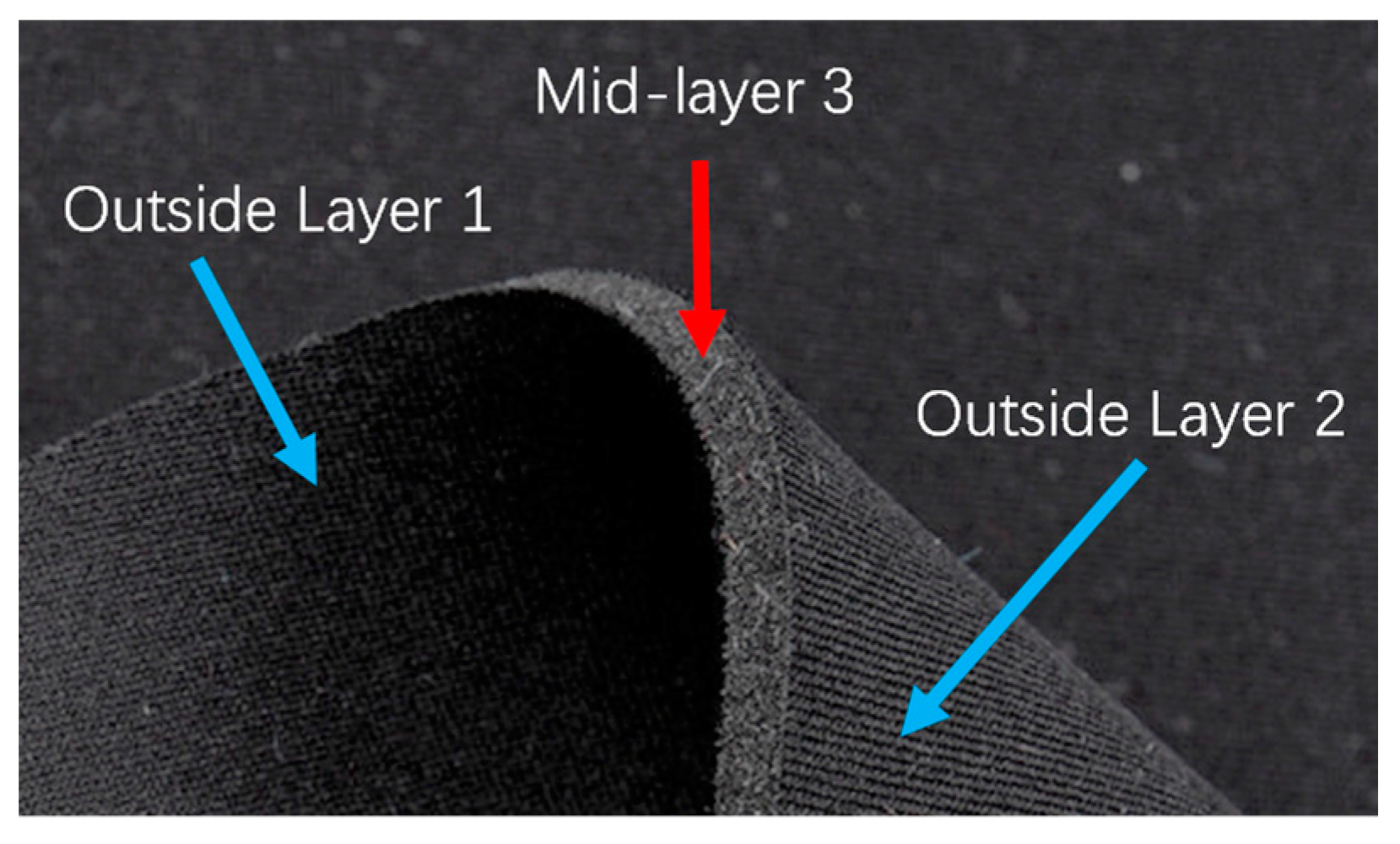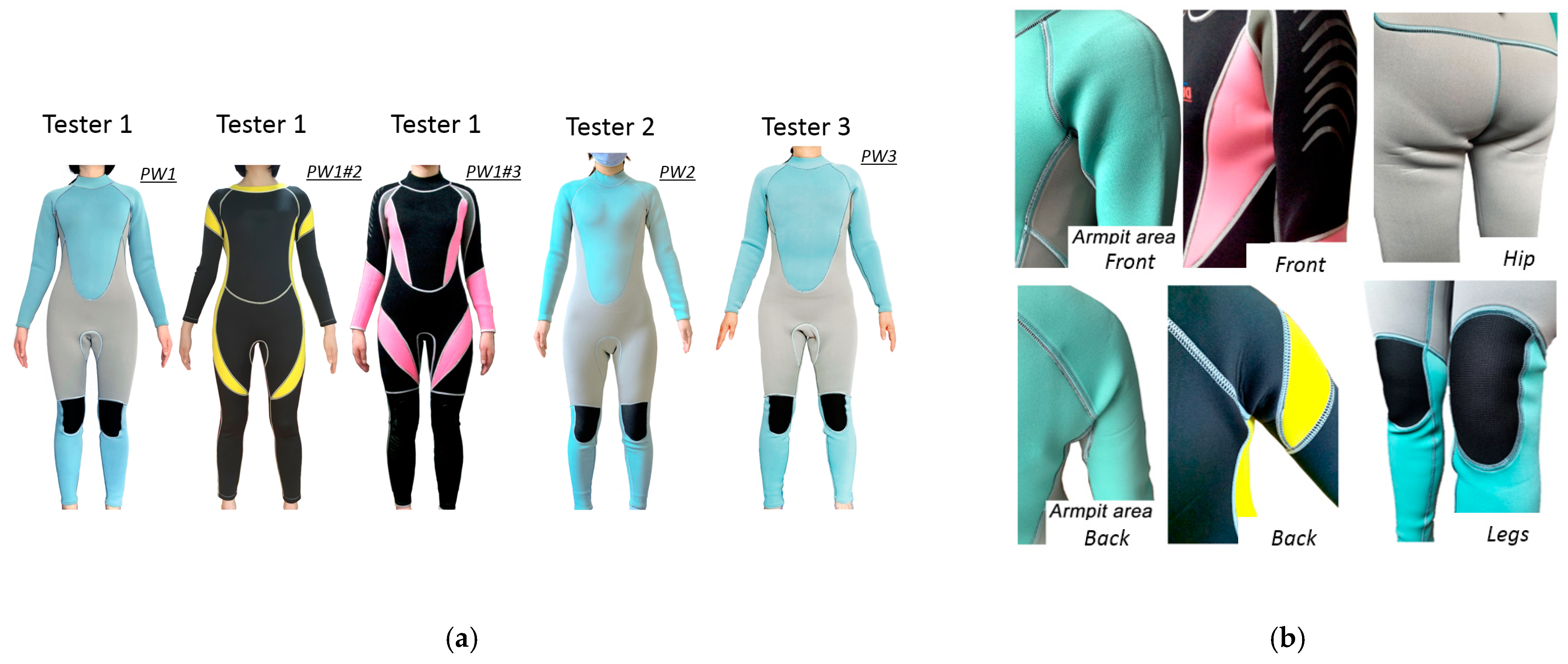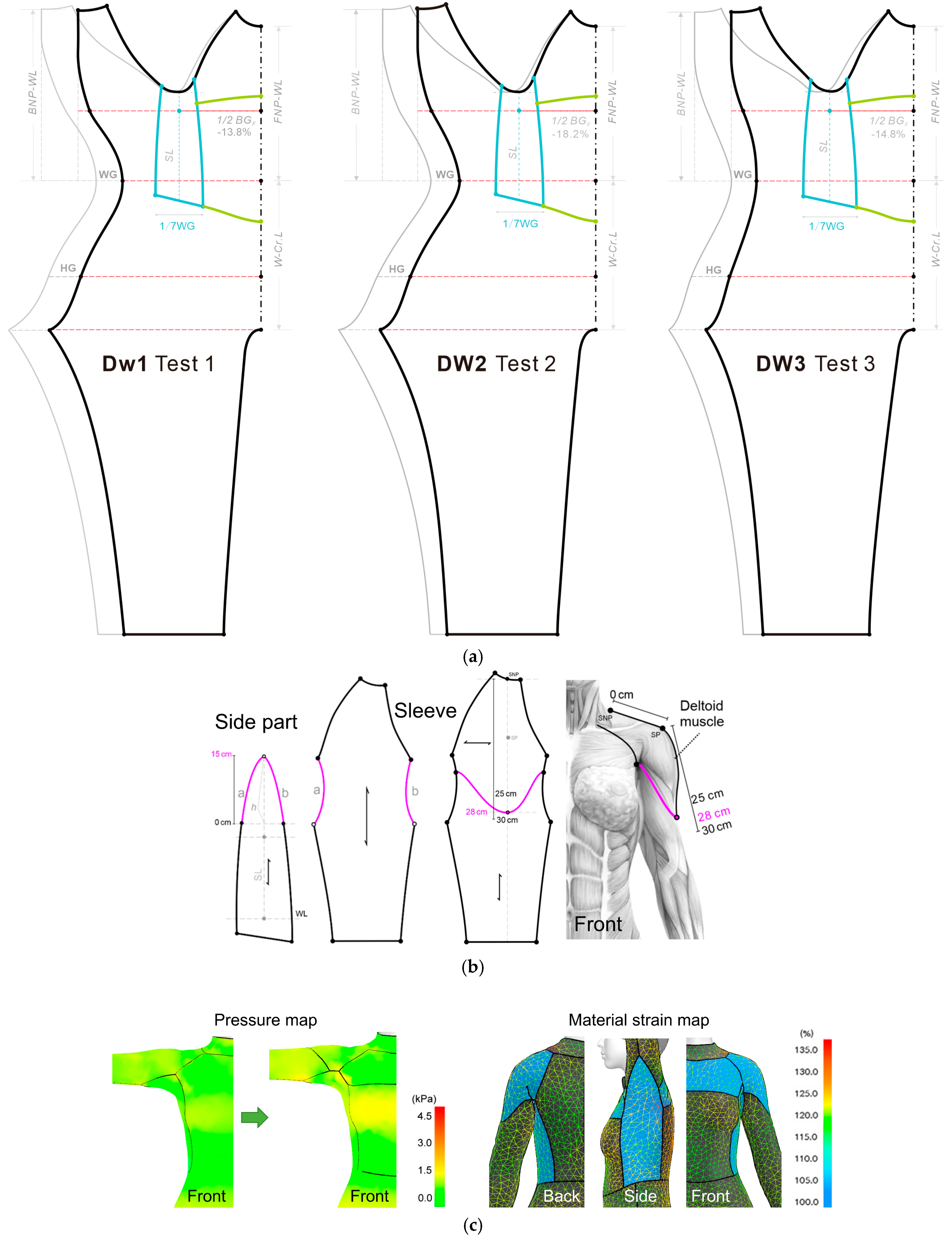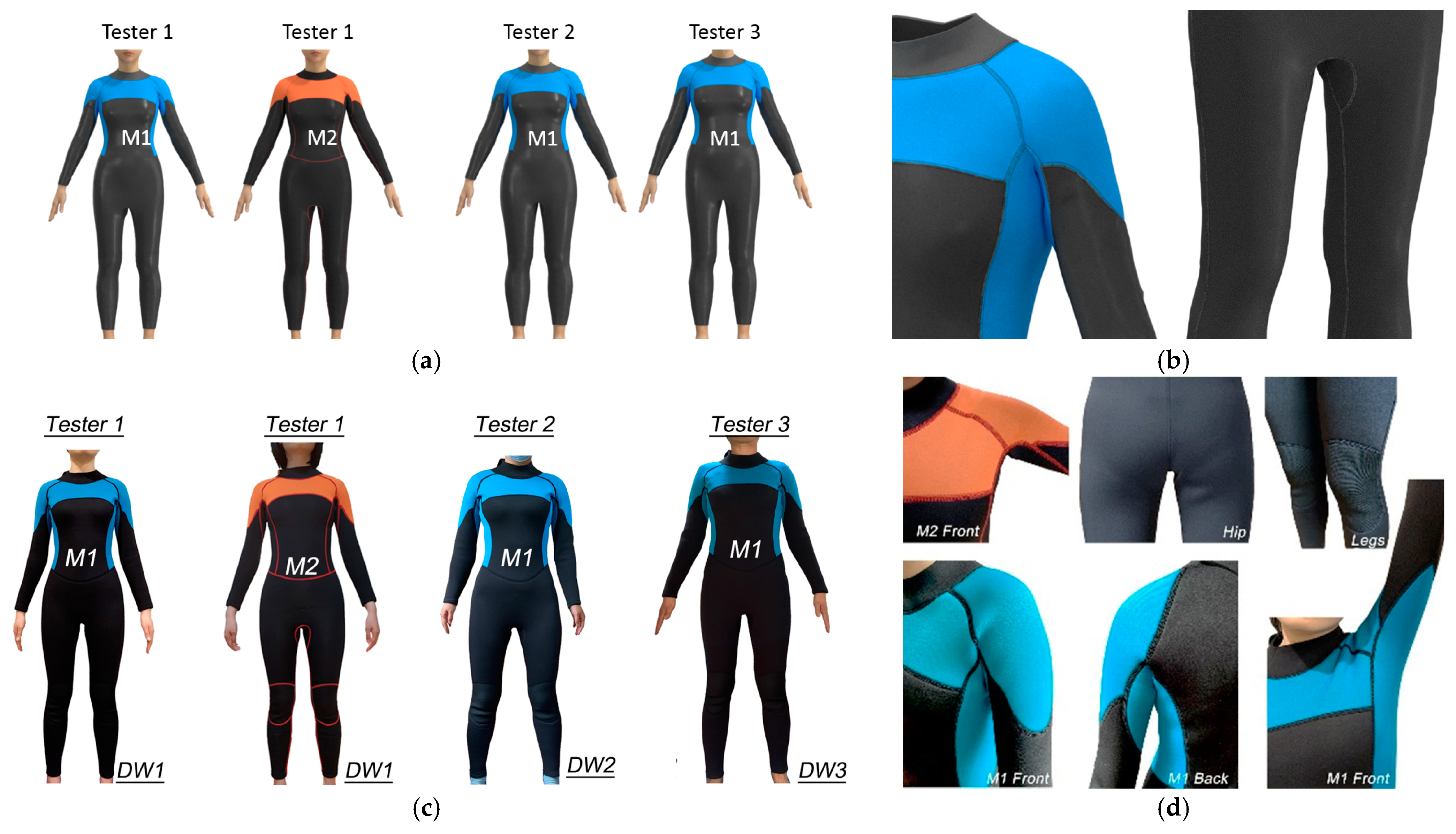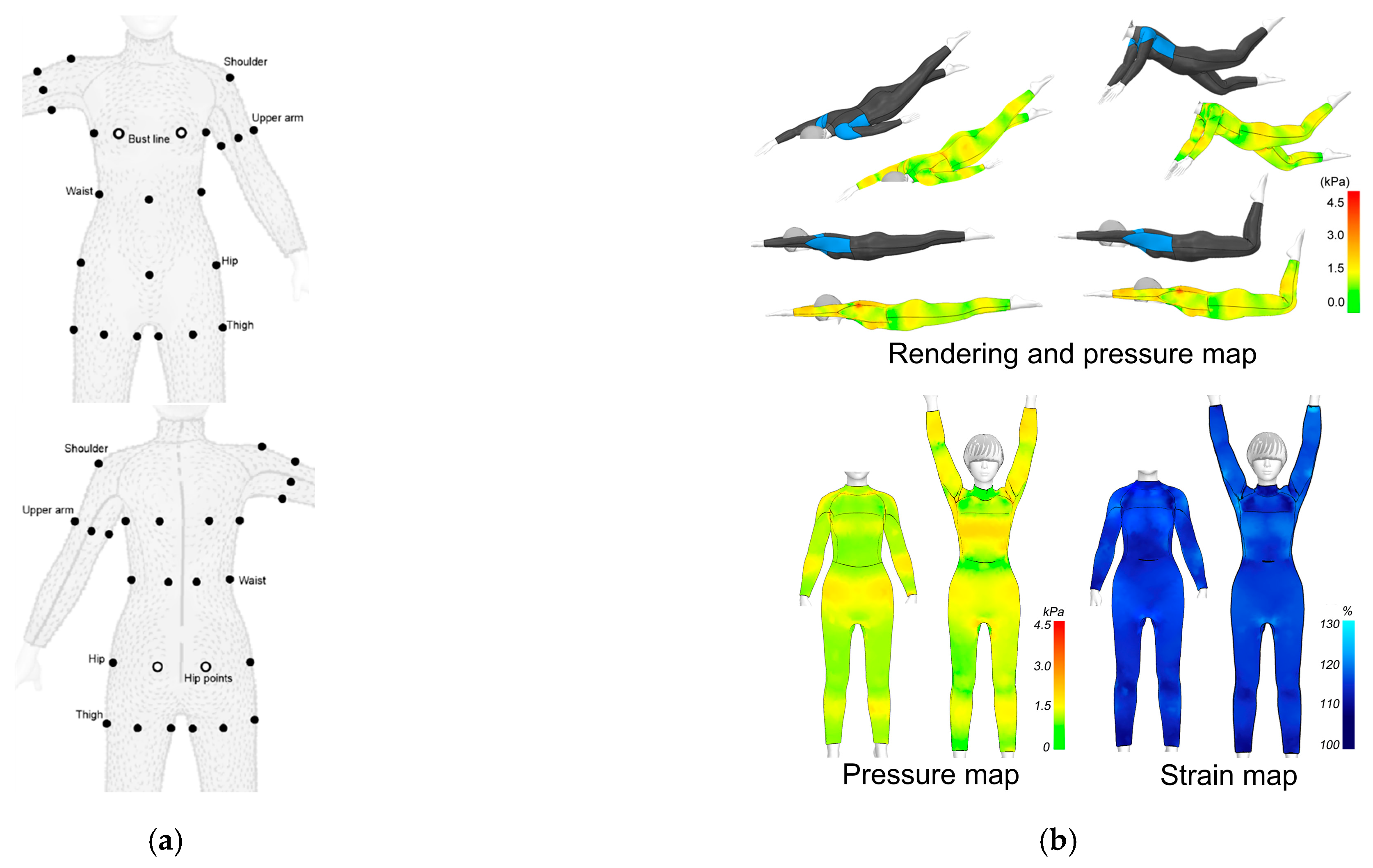1. Introduction
There are many diving clubs around the world, and millions of people participate in scuba diving every year. PADI has issued more than 28 million diver certifications since 1967 [
1,
2]. There are more than 1300 registered diving clubs in China, and according to statistics from the China Underwater Association (CUA) in 2020, the number of people participating in diving activities in China is more than 8 million. The wetsuit is the most common type of diving activity clothing and is helpful to divers underwater for insulation, protection and dynamic fit and function. A correct shape ensures optimal thermal conditions. A wetsuit that is too loose will allow too much water to circulate over the diver’s skin. A wetsuit that is too tight is very uncomfortable and can impair circulation. Therefore, the wetsuit must fit the diver’s body shape adequately. Currently, more than 60% of Chinese diving enthusiasts are females under 30 years old, and 58% of purchasers of diving goods are female; female and elderly divers attach great importance to the functionality of wetsuits [
3].
At present, most common wetsuit products on the market have problems such as poor fit (too loose or tight, water accumulation in the crotch), poor sports function (sports restriction), and poor thermal insulation. This is because there are few products based on scientific research, and the majority of mass-produced wetsuit products fail to meet users’ requirements for good function and comfort. More than half of females with diving experience from the Chinese diving online community experience feeling uncomfortable while wearing wetsuits. They report the order of commonly misfitting areas underwater as: shoulder (25.5%), waist (15.7%), upper arm (15.4%), bust (12.6%), and crotch, legs, and others (30.8%), mainly concentrated in the maximum activity area of the upper body parts. They are willing to improve the wetsuit design or customize it for their body morphologies. The shoulder area is a more complex part of the wetsuit and needs to be more deeply studied in terms of ergonomics, design, and textile material applications. As people’s fit needs become more diversified and personalized, it is essential to study the mode of design and development of functional clothing and its performance evaluation, so that people in different conditions can work and live safely, healthily and comfortably [
4].
However, the traditional way of developing wetsuits is still the mainstream research method, mainly using traditional modes of 2D pattern drawing, sample making, and subjective evaluation by real people or model dummies trying them on [
5,
6]. It is difficult for wetsuit enterprises using these traditional development methods to predict product problems before actual manufacturing or to cope with small batch or personalized wetsuit designs. They cannot respond quickly or even receive consumer feedback to identify problems, and this often results in wetsuit products with structural and functional problems in the market.
In addition, serious problems such as low resource utilization, excessive energy consumption, and high production costs are prevalent [
7]. For example, the middle layer of wetsuit material is mainly neoprene; its main component, polychloroprene, does not meet the Global Recycling Standard (GRS), its mechanical recovery is limited, and a large amount of hydrogen chloride is produced in the process of recovering chemicals through pyrolysis or energy recovery through combustion [
8,
9]. Therefore, using wrong samples and waste textile materials in the design process causes pollution and recycling problems. Only by solving these problems mentioned above can we achieve maximum use of our products and reduce the number of low-quality products, and this will also contribute to the good development of the human environment.
The application of virtual technology in light industry in recent years aims to solve these problems; the technology of virtual and real fusion simulation methods can be used for reference. The “fusion” data of the virtual and real world can accurately and effectively guide the virtual development and evaluation of wetsuits, reducing costs and resource waste [
10]. Constructing a garment design simulation and evaluation system based on virtual and real fusion can avoid repeated prototype development, accelerate product manufacture, and enhance control and quality of research and development [
11,
12]. Current wetsuit construction always draws and creates lines directly on the surface of a digital model and then converts 3D surfaces into 2D cutting parts, then uses 3ds Max, Optitex, and other software to carry out virtual design and trying on of the wetsuit [
13,
14,
15,
16]. High-precision 3D body scanning technology is used to construct human body models, obtain accurate measurements and analyze key body parts [
17,
18,
19]. This is crucial for creating clothing with strict fit standards. However, most existing studies have only scanned the human body in the standing position, and could not accurately reflect the dynamic wetsuit during some actions. Until now, no relevant schemes based on motion ergonomics, virtual and real design and comfort functional evaluation on the floor and underwater have been proposed.
In this study, a virtual human body and wetsuit were established based on 3D body scanning technology and virtual software. The new optimized wetsuit was designed based on female characteristics, and compared with existing wetsuit products in terms of structure and function. The fit performance of the optimized wetsuit was tested and analyzed through static and dynamic simulation, and positive results were obtained. This research process can be applied to wetsuit design and evaluation. This study provides an effective and feasible new method to replace the traditional design mode of wetsuits; it also provides scientific support for wetsuit enterprises’ design and production from the perspective of practical application, and improves the objectivity and accuracy of evaluation.
3. Results
3.1. Designed Wetsuit Virtual Construction
In order to solve the previously described problems, an optimized wetsuit design approach based on the relationship between dynamic posture change underwater, material properties and pressure sensitivity was proposed in our earlier work [
22]. Based on the previous results, in this study, the division lines of the armpit, upper arm and side of the wetsuit are reasonably designed to increase the fit degree of the upper limb movement while satisfying comfort according to the anatomical features and measurements of the human body. The design details are illustrated below.
As shown in
Figure 5a, to the wetsuit structure (black line) a value of −16.6% is added on the girths; this is the maximum acceptable comfortable stretch (the max. negative ease) of the wetsuit material on the human body. The wetsuit structure (gray line) has a value from −8 to 0% (the min. negative ease) added on the girths; the minimal negative value is just to make the wetsuit fit, but the maximum negative value is to make the wetsuit as tight as possible within the acceptable comfort range.
The designed wetsuit (DW) pattern was imported into CLO software to construct a virtual wetsuit. The commonly used materials, M1 and M2, were selected to make the DW in this study. The maximum elongation of the materials under 500 cN/cm is 30.2% and 27.8%, and the shrinkage is about 2% and 3%. Due to the particularity of wetsuit material, the default value of elastic knitted material is selected to conduct a simulation in CLO. The thickness (main value) is set to 3 mm, with the following property indicators: “Physical Property”—“Preset” is Knit_Jersey, “Density” is 400 g/m2 and 460 g/m2, “Simulation Properties”—“Shrinkage warp” is 100%, “Surface”—“Skin offset” is 0.1 mm. Two tools—“tack” to fix a wetsuit and “sewing” to sew wetsuit pieces—were applied to conduct try-on.
The torso side (
Figure 5a, blue line) is individually divided to provide high fit under the armpit, and to improve the excessive material stretch caused by upper arm movements. The width of the bottom of the side part is designed to be 8–12 cm, approximately one-seventh of the waist girth. The side part to sleeve connection uses a design of bullet type (
Figure 5b), increasing armpit flexibility as well as significantly reducing excess ease under the armpit. The raglan sleeve is designed to enhance the fit degree of the shoulder, and the division curve is within the average length 30 cm (the position of the lower deltoid) of the upper arm, which increases the flexibility of the shoulder.
The design has a horizontal division at the bust (
Figure 5a, green line), which provides good compression and control of the female bust area. It increases the dynamic tightness of the shoulder and neck parts. According to the average bust height, the additional bust seam is above the BL (bust line), and can be raised along the front center line 0–5 cm. The additional seam curve on the abdomen is below the WL (waist line), and declines 0–8 cm along the front center line.
It can be seen from
Figure 5c that the fit degree of the upper bust, arm and abdomen parts are obviously improved in the raised and natural positions based on the above designs. The measured virtual pressure on the bust (when the curve position is 0–5 cm) is from 1.98–1.77 kPa, and on the abdomen it can reach a maximum of 0.67 kPa at 8 cm. The experimental pressure results show that the best design, from the perspective of appearance and objective measurement, includes the curves 3 cm above BL and 8 cm below WL.
After several optimization steps, the DW pattern block is shown in
Figure 6a, and a perspective view of the 3D model and wetsuit is shown in
Figure 6b.
3.2. Wetsuit Subjective Evaluation
Real DW products in three sizes were also made for the same three testers. They are named DW1, DW2, and DW3. In order to further verify the consistency of the real and virtual wetsuits, the appearance, pressure and strain data were compared.
Figure 7 shows the wetsuit try-on simulation with two materials for three testers.
Figure 7a,c show that the visual appearance was evaluated by testers (tightness, appearance). It can be seen from the appearance that the virtual wetsuits are the same as the real ones; the virtual wetsuit, in standing position, has an appearance of fit and high consistency with the real ones.
Figure 7b,d show that the DW is almost without folds, and the design of the shoulder parts is more fitted than those of the previous PW after optimization.
The virtual and real wetsuits were further compared to check the accuracy and reliability of the virtual design. In a subjective test, the perceptual evaluation of each body part for real PW1, 2 and 3 and DW1(M1), 2 and 3 was rated using the Likert 7-level scale, as shown in
Figure 8.
It can be seen from
Figure 8 that DW has a high degree of satisfaction, and the wearing comfort has been significantly improved. The results of the static and dynamic (hands up) subjective evaluations indicate that the lower satisfaction ranking points (average is 4.07 ± 0.57 in static and 3.0 ± 0.69 in dynamic) of the PW are mainly found at the front knee (squatting), bust side, waist side, back, shoulder, and upper arm. The average results for the DW are the same, 6.73 ± 0.34 in static and 6.67 ± 0.31 in dynamic positions; the positive evaluation means that the rankings for our wetsuit design are higher than “6—highly satisfied” and significantly higher than the rankings of PW.
3.3. Wetsuit Objective Evaluation
The wetsuit objective evaluation includes two comparison experiments: the comparison of real and virtual products, and the comparison of real PW and DW samples.
In the comparison of real and virtual products, the real and virtual parameter values are tested and compared using AMI sensors and CLO respectively;
Figure 9 shows the test points and comparison maps between pressure and material strain in the virtual product;
Figure 9a shows 34 test points in six main parts;
Figure 9b shows the material pressure and strain of the wetsuit in virtual try-on. The dynamic changes of body parts after the arms are raised cause great material deformation, which leads to a relative pressure value change ΔP (equation 1). This is an important evaluation factor; the smaller the ΔP, the better the quality of the wetsuit.
wherein ΔP is a relative difference between the pressure measured in static and dynamic postures, %; P
d is the pressure when arms are raised, kPa; P
s is the pressure value when arms are down, kPa.
As shown in
Figure 9b, the green color means weaker pressure contact values generated by CLO, while a yellow or orange color means that the pressure values are stronger than green. The pressure distribution of the wetsuit in the static standing and dynamic positions is reasonable and balanced, without unusual conditions (very high or very low pressure values). When the arms are down, the average virtual and real P
s are 1.89 kPa and 1.65 kPa; when the arms are raised, the average virtual and real P
d are 1.75 kPa and 1.60 kPa. The deviation between real and virtual is less than 0.24 kPa, meaning that there is little difference between the virtual and real compression. It can be concluded that the objective compression experience can be used to predict real pressure performance.
As for virtual material strain (original value is 100%), when the arms are down, the average value in six positions is 13.1%; when the arms are raised, the average value is 16.2%. The wetsuit material strain is within the range of the real EMT measurements of the material, which is also close to the average value of the real design’s structural ease (−16.6%). The percentage difference between the values when the arms are up and down is less than 2.8 ± 4.1%.
For the comparison of real PW and DW samples, the objective pressure evaluation results are shown in
Table 5.
The results indicate that the maximum pressure ΔPPW measured on the upper arm was 324.4%, and the maximum pressure difference was −1.02 kPa. The maximum ΔPDW was 33.6%, and the maximum pressure difference was 0.37 kPa. We reduced the maximum pressure difference on the upper arm by 89.6% and the difference on the shoulder by 90.1% in the newly designed diving suit. In addition, the pressure balance in the waist and chest was appropriately enhanced, resulting in an average pressure greater than PW (0.4 kPa) and a better fit. At the same time, the standard deviation of the pressure in the six parts was kept at a smaller value.
The results show that the differences between the suit when the arms are down and up, in critical parts, are small, and that the wetsuit can adapt well to the deformation state in static and dynamic extreme conditions and provide stable pressure.
3.4. Evaluations Underwater
To further test the performance of DW in all aspects, an underwater experiment was carried out. The testers were equipped with SCUBAPRO professional equipment. Testers 1 and 2 conducted the test. The test project was conducted in a professional diving training center (Wuhan, China), and the water temperature was about 25 °C. Under the guidance of experienced instructors, the testers mainly dived underwater within 6 meters. The underwater dynamic motion includes replications of the postures shown in
Figure 9b, and more free swimming and diving.
It can be seen from the underwater professional camera results that in the diving postures, the shoulder, armpit, leg and other parts have no excessive loose volume (wrinkles), and the DW closely fits the human body (
Figure 10). After performing free swimming, diving and squatting, the subjective evaluation rating is nearly 6.90 ± 0.21 (
Figure 11). The shoulders and the knees can move well without any obvious restriction, and there is no local or overall water accumulation phenomenon. Therefore, the volunteers gave high ratings for the fit of the wetsuit.
4. Discussion
In this study, the research is divided into four stages: in the first stage, a 2D wetsuit pattern based on anthropometric measurements was designed to solve dynamic misfit problems in the shoulder, armpit, bust and other major parts, and the details were designed and optimized for real-time simulation and evaluation using a 3D system. The try-on effect and material strain were taken into account, as well as the simulation of some postures underwater. In the second stage, a virtual body model was generated based on measurement features of real human dynamic postures underwater, including deforming the human body and material using 3D software. The simulation was completed with the design of the minimum virtual ΔP and tensile strain values selected through pressure and strain analysis, and the ergonomic-based dynamic optimization in the upper limb and torso areas was completed.
In the third stage, the finished DW product was completed based on the simulation results for three testers. After a real try-on experiment, the performance results were highly consistent with the virtual results, the material pressure error was small (<0.24 kPa), and the virtual material strain value was also in line with the real design’s value. Finally, real underwater experiments were carried out, and the testers gave positive evaluations of the DW’s good dynamic performance at upper limbs, bust areas, etc. The results show that the wetsuit designed using the virtual system has a reasonable pressure range and good fit performance; the wetsuit can adapt well to static and dynamic wearing fitness and extreme deformation, and provide stable pressure. After an overall and detailed comparison, as well as subjective and objective analysis, the DW’s results were comprehensively better than those of the PW products in the market.
5. Conclusions
The whole research process shows that theoretical knowledge of virtual design and optimization can solve the practical problems of wetsuit development, and that the performance results of virtual and real experiments are consistent. The DW has a good static appearance on land, and meets the requirements of dynamic wearing comfort and sports function underwater well.
The technical results of this study provide an efficient and flexible way to develop and test enterprise products by effectively controlling labor and material costs and reducing sample production. The results will also help wetsuit designers to cope with rapid modification and evaluation, and improve customers’ wearing experience. It is possible to design a suitable wetsuit based on the tester’s size with high satisfaction. At the same time, the new wetsuit evaluation mode can avoid making a lot of samples for testers to try on, and it can also omit actual repetitive manufacturing work to increase productivity, significantly lower production costs, and reduce resource consumption. This also helps to improve the enterprise’s current state of scientific research and practical production.
This method will further promote the development of information technology in the field of industrial manufacturing and will explore the basic theoretical problems of virtual technology in the field of elastic materials and functional garments. It can help to solve bottleneck problems in simulation, evaluation and other key technologies in the current virtual systems used by the related manufacturing industry, and provide some references for virtual simulation and evaluation research, which has important economic value and scientific significance.

